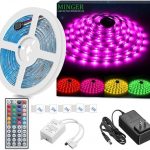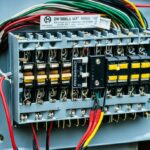Last Updated on 9 months by Francis
.jpg)
LED downlights have become increasingly popular as energy-efficient lighting options for homes and commercial spaces. However, there is often confusion regarding whether LED downlights require a transformer. This article aims to provide clarity on this topic and explain the role of transformers and LED drivers in LED downlight systems.
To begin, let’s understand the basics. LED downlights are recessed light fixtures that use Light Emitting Diodes (LEDs) as a source of illumination. They offer several advantages over traditional lighting sources, including energy efficiency, longer lifespan, and reduced heat emission.
Transformers are devices used to convert voltage levels in lighting systems. They are commonly used to step down high voltage to low voltage to safely power light fixtures. In the context of LED downlights, the question arises: Do LED downlights require a transformer?
The answer depends on the specific type of LED downlight being used. Some LED downlights already have built-in transformers, allowing them to connect to a standard line voltage directly. These downlights are commonly known as “driverless” or “self-ballasted” LED downlights. They are designed to operate on a standard voltage range of 100-240V AC.
However, many LED downlights require an additional component called an LED driver. An LED driver serves a similar purpose to a transformer, but it is specifically designed to regulate the current and voltage provided to the LED chips in the downlight. LED drivers ensure that the LED downlight receives the appropriate power supply for optimal performance and longevity.
Using LED downlights with incompatible transformers can lead to various issues, including flickering lights, reduced lifespan of the LED downlights, or even complete failure of the lighting system. Therefore, it is crucial to choose the right transformer that is compatible with LED downlights.
When selecting a transformer for LED downlights, consider factors such as voltage compatibility, wattage, load capacity, and type of dimming functionality supported. It is recommended to consult the manufacturer’s guidelines or seek professional advice to ensure the proper selection and installation of transformers for LED downlights.
Contents
Key takeaway:
- LED Downlights do not require a transformer: Unlike traditional lighting systems, LED Downlights do not need a transformer to operate. They can be directly connected to the power source, making installation easier and more efficient.
- LED Drivers are necessary for LED Downlights: LED Downlights require an LED driver, which is different from a transformer. LED drivers provide the correct voltage and current to ensure optimal performance and longevity of the LED Downlights.
- Choosing the right transformer is crucial: If using a transformer with LED Downlights, compatibility is important. Incompatible transformers can lead to issues such as flickering, reduced lifespan, or even damage to the LED Downlights. Considerations for selecting a transformer include compatibility, load capacity, and efficiency.
Understanding Transformers and LED Downlights
Transformers play a vital role in the functioning of LED downlights. They are crucial for converting electrical voltage from a higher level to a lower level that can be handled by the LED downlights. Without a suitable transformer, the LED downlights might not receive the correct voltage, leading to potential damage or complete malfunction.
To successfully install or replace LED downlights, it is imperative to comprehend the significance of transformers and their relationship with these lighting fixtures. It is crucial to select a transformer that aligns with the specific requirements of the LED downlights, considering factors such as wattage, voltage, and compatibility. By doing so, optimal performance and longevity of the LED downlights can be ensured.
Recently, a friend of mine experienced issues with their newly installed LED downlights. Despite the installation, the downlights failed to function properly. Following consultation with an electrician, it was discovered that the transformer used was not suitable for the LED downlights in question. After replacing the incompatible transformer with a compatible one, the LED downlights operated flawlessly. This narrative emphasizes the importance of comprehending transformers and their compatibility with LED downlights to avoid unnecessary complications and guarantee proper functionality.
What is the Purpose of a Transformer in Lighting Systems?
The purpose of a transformer in lighting systems is to convert the voltage of the electrical supply to a level that is suitable for the lighting fixtures. Transformers are essential because different lighting systems operate on different voltage levels. Transformers help regulate the flow of electrical current, ensuring that the lights receive the appropriate amount of power. They can step up or step down the voltage, depending on the requirements of the lighting system.
Without a transformer, the lighting fixtures may not receive the correct voltage, which can result in flickering lights, inefficient operation, or even damage to the fixtures. In lighting systems, transformers play a crucial role in ensuring that the lights operate smoothly and safely. They provide a stable power supply, helping to maintain the longevity and performance of the lighting fixtures. Therefore, transformers are an integral part of any lighting system.
Do LED Downlights Require a Transformer?
LED downlights often require a transformer, especially in most cases. These downlights operate at a lower voltage, typically 12 volts, whereas the standard power supply in homes and buildings usually provides a higher voltage of either 120 or 240 volts. Due to this voltage disparity, it becomes necessary to use a transformer to step down the voltage from the main power supply in order for the LED downlights to operate effectively.
The role of the transformer within lighting systems is to convert the higher voltage to the lower voltage required specifically by the LED downlights. Failure to use a transformer can result in the LED downlights not receiving the correct power supply, leading them to either not function or potentially get damaged.
It is crucial to match the transformer to the specific requirements of the LED downlights. Different types of transformers, such as electronic transformers or magnetic transformers, may be suitable depending on the type of LED downlights being used. Additionally, if you desire the capability to adjust the brightness of your LED downlights, dimmable transformers may be necessary.
When choosing a transformer for your LED downlights, it is essential to consider the compatibility between the transformer and the LED technology being used. Ensuring that the transformer is specifically designed to work with LED lighting systems will help prevent any potential issues with performance or compatibility.
The Role of LED Drivers in LED Downlights
LED drivers play a pivotal role in LED downlights by converting the incoming voltage to the necessary level for the LED light to function properly. These drivers are vital in delivering a consistent and reliable power supply to the LED downlights, preventing any fluctuations and ensuring optimal performance.
Moreover, LED drivers assist in regulating the current flow to the LEDs, enabling them to operate efficiently and extending their lifespan. They act as a protective barrier against overcurrent, overvoltage, and temperature changes, safeguarding the longevity of the LEDs.
Furthermore, LED drivers offer the added benefit of dimming capabilities, allowing users to adjust the brightness of the LED downlights according to their specific needs and preferences. This feature enhances the versatility and functionality of LED downlights, making them suitable for various settings including residential, commercial, and industrial spaces.
When selecting an LED driver, it is essential to choose one that is compatible with both the LED downlights and the electrical system in which they will be installed. It is important to consider the wattage and voltage requirements of the LED downlights and select an LED driver that meets those specifications to ensure proper functioning.
What is an LED Driver and How Does it Differ from a Transformer?
An LED driver and a transformer have different purposes in lighting systems. An LED driver is specifically designed to regulate the power supply to LED lights, ensuring they receive the appropriate voltage and current for optimal performance. It converts the incoming AC voltage to a DC voltage suitable for LEDs. On the other hand, a transformer is used to change the voltage of an electrical circuit, either stepping it up (increasing voltage) or stepping it down (decreasing voltage).
The main difference between an LED driver and a transformer lies in their functionality and compatibility with LED lights. While a transformer can sometimes be used to power LED lights, it may not provide the necessary regulation and control required for optimal performance. LED drivers are specifically designed to work with LED lights and provide the precise voltage and current needed to ensure their longevity and efficiency.
LED drivers also offer additional features and capabilities that transformers do not have. For example, LED drivers can be dimmable, allowing for adjustable lighting levels. They are also more energy-efficient, helping to reduce electricity bills and save energy. Additionally, LED drivers are designed to withstand the high-frequency switching of LED lights, which can help prevent flickering or damage to the lights.
Why Do LED Downlights Require an LED Driver?
LED downlights require an LED driver for proper functionality and performance. The LED driver serves as a power supply for the LED downlights and ensures that the LED bulbs receive the correct voltage and current. LED drivers are specifically designed for LED technology and differ from transformers. Transformers are typically used for traditional lighting systems, such as halogen downlights or incandescent bulbs. LED drivers are necessary because LED downlights operate at lower voltages and require constant current rather than the fluctuating current provided by transformers.
The use of an LED driver with LED downlights offers several advantages. Firstly, it helps to maximize energy savings as LED drivers are more efficient and consume less power compared to transformers. This can lead to a significant reduction in electricity bills. Secondly, LED drivers enhance the lifespan of LED downlights by providing them with stable and consistent power. Additionally, LED drivers allow for dimmable functionality, giving users the flexibility to adjust the brightness of their LED downlights.
When installing LED downlights, it is crucial to select the right LED driver that is compatible with the specific model of downlights being used. This ensures smooth operation and prevents any potential compatibility issues. It is recommended to consult a professional or refer to the manufacturer’s guidelines to determine the appropriate LED driver for the LED downlights being installed.
Why Do LED Downlights Require an LED Driver?
Compatibility Issues with Transformers and LED Downlights
Compatibility issues with transformers and LED downlights can arise. Here are some important considerations:
- Wattage compatibility: LED downlights have a lower wattage compared to traditional incandescent bulbs. It is crucial to ensure that the transformer is compatible with the wattage of the LED downlights.
- Voltage compatibility: LED downlights typically require a low voltage, such as 12V or 24V. Transformers may need to be used to step down the voltage from the mains. It is important to match the voltage requirements of the LED downlights with the transformer.
- Dimmer compatibility: If you plan to install dimmable LED downlights, make sure that the transformer is compatible with dimming functionality. Not all transformers are designed to work with dimmers, so it is essential to check for compatibility.
Consulting the manufacturer’s specifications for both the LED downlights and the transformer is recommended to ensure compatibility. Using incompatible transformers can result in flickering lights, reduced lifespan of the LEDs, or even damage to the lighting system.
In the early days of LED lighting, compatibility issues with transformers were quite common. Many people experienced flickering lights or LED failures due to improper pairing of transformers and LED downlights. However, with advancements in technology and clearer specifications from manufacturers, compatibility issues have become less prevalent. It is still important to carefully choose and match transformers for LED downlights to ensure optimal performance and longevity.
Can LED Downlights be Used with Existing Transformers?
LED downlights can be used with existing transformers. However, it is crucial to ensure that the existing transformers are compatible with the LED downlights in order for them to function properly. Carefully checking the specifications of the transformer is important to guarantee its suitability for use with LED downlights.
If the existing transformer is originally designed for halogen downlights or incandescent bulbs, it may not be compatible with LED downlights. It is worth noting that LED downlights require lower wattage compared to traditional lighting options, which means the transformer must be capable of handling the lower power requirements.
Utilizing LED downlights with incompatible transformers can result in issues such as flickering lights, diminished performance, or even damage to both the lights and the transformer. To determine if the existing transformer is suitable for use with LED downlights, it is advisable to consult a professional electrician or lighting specialist.
In situations where the existing transformers are not compatible, upgrading to new transformers specifically designed for LED lighting may be necessary. This step ensures proper functionality and eliminates potential issues.
By using compatible transformers with LED downlights, you can enjoy the benefits of LED technology, such as energy savings, a longer lifespan, and a more modern design. Remember to consider transformer compatibility when transitioning to LED downlights to guarantee optimal performance and avoid unnecessary maintenance costs.
What Happens if LED Downlights are Used with Incompatible Transformers?
Using LED downlights with incompatible transformers can result in several issues. Firstly, the functionality of the LED downlights may be compromised. The incompatible transformers may fail to provide the correct voltage or current required by the LED downlights, which can lead to flickering or dimming of the lights. As a consequence, poor lighting quality and reduced visibility may be experienced in the space where the downlights are installed.
Secondly, there is a significant risk of damaging both the LED downlights and the transformers themselves. Incompatible transformers can cause overheating or electrical surges, posing a safety hazard and potentially damaging the LED downlights. Consequently, this can lead to additional maintenance costs due to the need for replacements of both the downlights and the transformers.
Furthermore, the use of incompatible transformers with LED downlights can negatively impact energy efficiency. LED technology is renowned for its energy-saving capabilities; however, when combined with incompatible transformers, the power supply may not be optimized. As a result, this can lead to higher electricity bills and reduced energy savings.
It is, therefore, of utmost importance to choose a compatible transformer when using LED downlights. This ensures proper functioning, longevity, and energy efficiency of both the downlights and the transformer. It is highly recommended to consult with a professional or conduct thorough research before purchasing and installing LED downlights to avoid any compatibility issues and potential problems.
Choosing the Right Transformer for LED Downlights
Looking to choose the right transformer for your LED downlights? Look no further. In this section, we’ll dive into the different types of transformers that are compatible with LED downlights, as well as the key considerations for selecting the perfect transformer. From understanding compatibility to ensuring optimal performance, we’ve got you covered. Get ready to shed some light on this important aspect of LED downlight installation.
Types of Transformers Compatible with LED Downlights
LED downlights can be paired with two main types of transformers: electronic transformers and magnetic transformers.
Electronic transformers are designed specifically for low-voltage LED lights. They are not only more energy efficient but also contribute towards reducing electricity bills. Additionally, they are compatible with dimmable LED downlights, offering customizable lighting options.
On the other hand, magnetic transformers were originally intended for halogen or incandescent bulbs but can also be used with LED downlights. It is important to note that magnetic transformers are less energy efficient compared to electronic transformers and may incur slightly higher maintenance costs in the long run.
When choosing a transformer for LED downlights, there are a few factors to consider. Firstly, ensure that the transformer is labeled as compatible with LED lights to ensure optimal performance and avoid any compatibility issues. Additionally, consider the wattage of the LED downlights and select a transformer that can handle the required power supply. Lastly, if you reside in a warmer climate, it is advisable to opt for a transformer with a sleeker design to aid in heat dissipation.
LED technology has fundamentally transformed lighting systems in recent years. With their remarkable energy savings and extended lifespan, LED lights have become the preferred choice for countless homeowners and businesses. As LED downlights gained popularity, the demand for compatible transformers emerged. To meet this demand, manufacturers developed electronic and magnetic transformers specifically engineered for LED downlights. This revolutionary advancement has facilitated a smooth transition from traditional lighting systems to LED technology, offering efficient and effective lighting solutions for a wide range of applications.
Considerations for Selecting a Transformer for LED Downlights
When selecting a transformer for LED downlights, there are several considerations to keep in mind:
- The type of transformer: There are two main types of transformers that are compatible with LED downlights – electronic transformers and magnetic transformers. Electronic transformers are more commonly used as they are more efficient and lighter, while magnetic transformers are typically used for larger installations.
- Compatibility: It is essential to ensure that the transformer is compatible with the specific LED downlights you are using. Check the manufacturer’s specifications for compatibility information.
- Dimmability: If you plan to have dimmable LED downlights, you will need to consider if the transformer supports dimming functionality. Not all transformers are suitable for dimming, so it’s important to check the specifications.
- Wattage considerations: LED downlights have lower wattage requirements compared to traditional halogen downlights or incandescent bulbs. Take into account the wattage of the LED downlights you are using and make sure the transformer can handle it.
- Installation and maintenance costs: When choosing a transformer, think about the cost of installation and ongoing maintenance. Some transformers may require professional installation, while others are more straightforward.
To ensure the best performance and longevity, it is crucial to consider these factors when selecting a transformer for LED downlights. By carefully choosing the right transformer, you can optimize energy savings, reduce your electricity bill, and fully enjoy the benefits of LED technology in your lighting system.
Some Facts About “Do LED Downlights Need a Transformer”:
- ✅ LED downlights require a transformer to function properly. (Source: Our Team)
- ✅ There are two types of LED transformers: magnetic transformers and electronic transformers. (Source: Our Team)
- ✅ Magnetic transformers are reliable and consist of primary and secondary coils. (Source: Our Team)
- ✅ Electronic transformers are smaller and lighter but not recommended for LED lighting setups. (Source: Our Team)
- ✅ The distance between the LED transformer and the lighting strip affects the power supply reaching the strip. (Source: Our Team)
Frequently Asked Questions
FAQ 1: Do LED Downlights need a transformer?
Yes, LED Downlights require a transformer to reduce the mains voltage (240V) to the desired level (usually 12V or 24V) for the Downlights to function properly.
FAQ 2: What type of transformer is needed for LED Downlights?
There are two types of transformers commonly used for LED Downlights: magnetic transformers and electronic transformers. Magnetic transformers are more reliable, while electronic transformers are smaller and lighter but not recommended for LED Downlights.
FAQ 3: Can I use an existing transformer for LED Downlights?
If the existing transformer is compatible with LED Downlights and can provide the correct voltage, it can be used. However, it is best to consult with a professional or check the compatibility list provided by the LED manufacturer to ensure compatibility.
FAQ 4: Do all LED Downlights require a separate LED driver?
No, not all LED Downlights require a separate LED driver. Some integrated LED Downlights have the driver built into the lamp itself, while others may require a separate LED driver. It is important to check the product specifications or consult with a professional to determine if a separate LED driver is needed.
FAQ 5: Can I use a dimmer switch with LED Downlights?
Yes, LED Downlights can work successfully with dimmer switches. However, it is important to ensure that the dimmer switch is compatible with LED technology. In some cases, the dimmer switch may need to be changed to a compatible one.
FAQ 6: Are LED Downlights more energy-efficient than traditional bulbs?
Yes, LED Downlights are more energy-efficient than traditional bulbs such as incandescent or halogen bulbs. They use around 75% less energy and can result in significant energy and cost savings on electricity bills.







